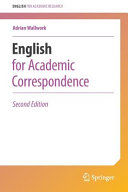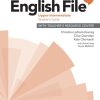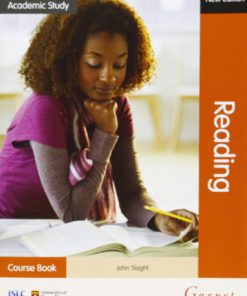English for Academic Correspondence 2nd Edition by Adrian Wallwork ISBN 9783319264356 3319264354
$50.00 Original price was: $50.00.$25.00Current price is: $25.00.
English for Academic Correspondence 2nd Edition by Adrian Wallwork – Ebook PDF Instant Download/Delivery: 9783319264356 ,3319264354
Full download English for Academic Correspondence 2nd Edition after payment

Product details:
ISBN 10: 3319264354
ISBN 13: 9783319264356
Author: Adrian Wallwork
English for Academic Correspondence 2nd Edition Table of contents:
Chapter 1: Subject Lines
1.1 What’s the buzz?
1.2 Write the subject line imagining that you are the recipient
1.3 Combine your subject line with the preview pane
1.4 Use the subject line to give your complete message
1.5 Consider using a two-part subject line
1.6 Be specific, never vague
1.7 Include pertinent details for the recipient
1.8 Examples of subject lines
Chapter 2: Salutations
2.1 What’s the buzz?
2.2 Spell the recipient’s name correctly
2.3 Use an appropriate initial salutation and be careful with titles
2.4 Avoid problems when it is not clear if the recipient is male or female, or which is their surna
2.5 Be as specific as possible when addressing an email to someone whose name you do not know
2.6 If in doubt how to end your email, use Best regards
2.7 Don’t use a sequence of standard phrases in your final salutation
2.8 Ensure your signature contains everything that your recipient may need to know
2.9 Avoid PSs and anything under your signature
Chapter 3: Structuring the Content of an Email
3.1 What’s the buzz?
3.2 Plan your email and be sensitive to the recipient’s point of view
3.3 Begin with a greeting + recipient’s name
3.4 Assume that no one will read more than the first sentence / paragraph
3.5 Remind the recipient who you are when previous contact has only been brief
3.6 If there has been no previous contact, give reason for your email immediately
3.7 Make it clear who should read your email and what it is you are requesting
3.8 Indicate to multiple recipients who actually needs to read the mail
3.9 Organize the information in the most logical order and only include what is necessary
3.10 Avoid templates for beginnings and endings
3.11 Bear in mind that long emails will be scrolled
3.12 When you have something negative to say use the ‘sandwich’ technique’
3.13 Use link words in long emails to show connections and to draw attention to important point
3.14 Ensure that recipients in different time zones will interpret dates and times correctly
3.15 Be aware of the importance of an email—not just for you or your recipient, but also fo
3.16 The last words
3.17 Don’t cc people unless strictly necessary
3.18 Be explicit in your the main text of your email that you have attached a document
Chapter 4: Building a Relationship and Deciding the Level of Formality
4.1 What’s the buzz?
4.2 How to judge the level of formality
4.3 Use appropriate language and don’t mix levels of formality
4.4 Note any differences in style and level of formality between English and your language
4.5 Be careful of your tone when asking people to do something for you
4.6 Show your recipient respect and motivate them to reply
4.7 Use common interests to establish and cement a relationship
4.8 Maintain a friendly relationship
4.9 Adopt a non-aggressive approach
4.10 Add a friendly phrase at the end of an email
4.11 An example of how a simple and friendly request can lead to a possible collaboration
Chapter 5: Language, Translating and Spelling
5.1 What’s the buzz?
5.2 Minimize mistakes in your English by writing short and simple emails
5.3 Don’t experiment with your English, instead copy / adapt the English of the sender
5.4 Be concise and precise
5.5 Use short sentences and choose the best grammatical subject
5.6 Use the correct word / phrase order
5.7 Avoid ambiguity
5.8 When using pronouns ensure that it is 100% clear to the recipient what noun the pronoun refer
5.9 Use standard phrases rather than translations from your own language
5.10 Don’t exaggerate or sound insincere
5.11 Beware of the potential dangers of Google Translate
5.12 Be careful how you use pronouns
5.13 Check your spelling and grammar
5.14 Don’t rely 100% on your spell checker
5.15 If the mail is very important, have it checked by an expert
Chapter 6: Requests and Replies
6.1 What’s the buzz?
6.2 Lay out your request clearly
6.3 Don’t assume that the reader will understand the importance of or reason for your request
6.4 Motivate the recipient to reply by empathizing with their situation or by paying them a co
6.5 Give the recipient all the information they need
6.6 Consider not sending an attachment to someone with whom you have had no previous contact
6.7 Include all the relevant information that the recipient needs to assess your request
6.8 When asking someone to review your work, give explicit instructions
6.9 Avoid blocks of text and don’t force your reader to make sense of everything
6.10 Decide whether it might be better just to make one request rather than several
6.11 For multiple requests, include a mini summary at the end of the email
6.12 When making multiple requests, ensure that each individual request is clear
6.13 Give deadlines
6.14 When you receive a reply, be prepared to ask for clarifications
6.15 In replies to requests consider inserting your answers within the body of the sender’s e
6.16 Insert friendly comments within the body of the sender’s text
Chapter 7: Cover Letters for Summer Schools, Internships, Placements, Erasmus, PhD / MA / Postdoc P
7.1 What’s the buzz?
7.2 Begin your letter with a heading to indicate what job you are applying for
7.3 Initial salutation
7.4 First paragraph (introduction)
7.5 Second / third paragraphs
7.6 Closing paragraph
7.7 Final salutation
7.8 Recognize the importance of such letters and triple check everything
7.9 Erasmus programme
7.10 Workshop
7.11 Summer school
7.12 PhD application
7.13 Placement
7.14 Research position / Internship
Chapter 8: Reference Letters
8.1 What’s the buzz?
8.2 What is a reference?
8.3 Asking for a reference letter
8.4 Typical questions that a reference letter addresses
8.5 Writing your own reference letter
8.6 Structure and template reference letter
Chapter 9: Brief Notes on Writing Research Proposals and Research Statements
9.1 What’s the buzz?
9.2 Writing a research proposal for external funding
9.3 Writing a research proposal for PhD or Postdoc position
9.4 Differences between a research proposal for a PhD program or Postdoc position
9.5 Writing a Statement of Purpose or Research Interest
Chapter 10: How to Criticize Constructively
10.1 What’s the buzz?
10.2 Decide whether email is the best format to make a criticism
10.3 Think about the context that your reader will be in when reading your email
10.4 Structure your email so that the focus is not only on the criticism
10.5 Use the first words set a positive tone
10.6 Be constructive in your criticism
10.7 Be diplomatic and make detailed comments rather than unspecific observations
10.8 Avoid being too direct when asking for clarification and making suggestions
10.9 When you have some good to say use shorter sentences; use longer sentences for ‘bad’ news
10.10 Use positive wording
10.11 Conclude your report by saying something positive
10.12 Re-read everything before you hit the “send” button
10.13 Be diplomatic when sending reminders
10.14 Be appreciative when thanking someone for doing an informal review of your work
Chapter 11: Writing a Peer Review
11.1 What’s the buzz?
11.2 Be clear about your role as a reviewer
11.3 Read your journal’s review guidelines
11.4 How to structure a referee’s report: (1) acceptance subject to revisions
11.5 How to structure a referee’s report: (2) complete rejection
11.6 How to structure a referee’s report: (3) acceptance as is
11.7 Bear in mind the authors’ expectations of you as a reviewer
11.8 Before you begin your report, put yourself in the author’s shoes
11.9 Use the sandwich approach: begin and end on a positive note
11.10 Use a soft approach when criticizing
11.11 Avoid the temptation to insult the author
11.12 Don’t just use should to make recommendations
11.13 Use separate paragraphs to outline your comments
11.14 Make sure your comments are explicit and explain how they could be implemented
11.15 Use you to address the authors, and I (i.e., the first person) to make reference to your
11.16 Don’t make indiscriminate comments about the level of English
11.17 Be careful of your own level of English and spelling
11.18 My plea to referees with regard to author’s level of English
Chapter 12: Writing a Reply to the Reviewers’ Reports
12.1 What’s the buzz?
12.2 Remember that yours is not the first paper to have been rejected
12.3 Structure your reply to the referees in a way that will keep referees and editors happy
12.4 Present your answers to the reviewers using the clearest possible layout
12.5 Be brief
12.6 Call yourselves we not the authors
12.7 Don’t be embarrassed to say you don’t understand the referee’s comments
12.8 Use the present and present perfect to outline the changes you have made
12.9 Justify why and where you have not made changes
12.10 If you disagree with the reviewers, always be diplomatic
12.11 If a reviewer finds a limitation in your work, deal with the criticism constructively
12.12 Don’t find things to criticize in the referee’s work or in the workings of the jour
12.13 Be aware of what might happen if you ignore the referee’s advice
Chapter 13: Communicating with the Editor
13.1 What’s the buzz?
13.2 Focus only on what you need to achieve
13.3 Ensure your cover email / letter is clear and accurate
13.4 If you’ve only made a few changes, describe them in the letter to the editor
13.5 Mention whether the manuscript has already been revised by a native speaker
13.6 Be diplomatic in any emails to check the progress of your manuscript
Chapter 14: Useful Phrases
14.1 What’s the buzz?
14.2 Initial salutation
14.3 Final salutation
14.4 Phrase before final salutation
14.5 Giving main reason for message
14.6 Organizing content
14.7 Asking favors / giving help
14.8 Invitations
14.9 Making inquiries
14.10 Replying to inquiries
14.11 Talking about the next step
14.12 Giving and responding to deadlines
14.13 Chasing
14.14 Making arrangements for meetings and teleconferences
14.15 Sending documents for informal revision
14.16 Receiving and commenting on documents for informal revision
14.17 Referees reports
14.18 Author’s reply to referees and editors
14.19 Generic problems
14.20 Asking for and giving clarification
14.21 Thanking
14.22 Apologizing
14.23 Sending attachments
14.24 Technical problems with email
14.25 Out of office message
Chapter 15: Tense Usage
15.1 What’s the buzz?
15.2 Use of the present simple
15.3 Non-use of the present simple
15.4 Use of the present continuous
15.5 Non-use of continuous forms
15.6 Future simple [will]
15.7 Future continuous
15.8 be going to
15.9 Past simple
15.10 Present perfect simple
15.11 Present perfect continuous
15.12 Non-use of present perfect continuous
15.13 The imperative form
15.14 Zero and first conditional forms
15.15 Second conditional
15.16 Third conditional
15.17 Modal verbs expressing ability and possibility: can, could, may, might
15.18 Modal verbs expressing advice and obligation: have to, must, need, should
15.19 Modal verbs for offers, requests, invitations, and suggestions: can, may, could, would, shal
15.20 Word order
15.21 Link words
People also search for English for Academic Correspondence 2nd Edition:
english for academic correspondence pdf
english for academic purposes syllabus
english for academic and professional purposes syllabus
english for academic study
english for academic purposes
You may also like…
Languages - English as a Foreign Language & Reference
English for Academic Research: Grammar, Usage and Style 2nd Edition Adrian Wallwork
Languages - English as a Foreign Language & Reference
English for Writing Research Papers 3rd Edition by Adrian Wallwork ISBN 9783031310720 3031310721
Languages - English as a Foreign Language & Reference
Languages - English as a Foreign Language & Reference
English for Academic Research A Guide for Teachers 1st Edition Adrian Wallwork
Languages - English as a Foreign Language & Reference
English for Academic Study Reading Course Book Edition 2 John Slaght
Languages - English as a Foreign Language & Reference
English for Writing Research Papers 3rd Edition Adrian Wallwork
Languages - English as a Foreign Language & Reference
Giving An Academic Presentation In English: Intermediate Level 1st Edition Adrian Wallwork
Languages - General & Miscellaneous Languages - Reference
English for Academic & Professional Purposes 1st Edition by Paolo Niño, M Valdez










